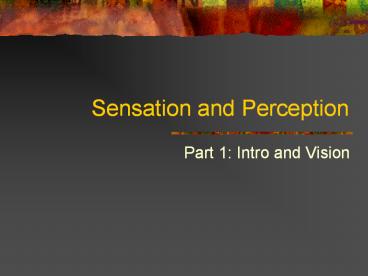Sensation and Perception - PowerPoint PPT Presentation
1 / 17
Title:
Sensation and Perception
Description:
Sensation and Perception Part 1: Intro and Vision Sensation and Perception: The Distinction Sensation: stimulation of sense organs Perception: selection, organization ... – PowerPoint PPT presentation
Number of Views:133
Avg rating:3.0/5.0
Title: Sensation and Perception
1
Sensation and Perception
- Part 1 Intro and Vision
2
Sensation and Perception The Distinction
- Sensation stimulation of sense organs
- Perception selection, organization, and
interpretation of sensory input - Psychophysics the study of how physical stimuli
are translated into psychological experience
3
Psychophysics Basic concepts
- Sensation begins with a detectable stimulus
- Fechner the concept of the threshold
- Absolute threshold detected 50 of the time
- Just noticeable difference (JND) smallest
difference detectable - Webers law size of JND proportional to size of
the initial stimulus
4
Psychophysics Concepts and Issues
- Psychophysical Scaling Fechners Law
- Signal Detection Theory Sensory processes and
decision processes - Subliminal Perception Existence vs. practical
effects - Sensory Adaptation decline in sensitivity
5
Vision The Stimulus
- Light electromagnetic radiation
- Amplitude perception of brightness
- Wavelength perception of color
- Purity mix of wavelengths
- Perception of saturation or richness of colors
6
The Eye converting Light into Neural Impulses
- The eye housing and channeling
- Components
- Cornea where light enters the eye
- Lens focuses the light rays on the retina
- Iris colored ring of muscle, constricts or
dilates via amount of light - Pupil regulates amount of light
7
The Retina An Extension of the Central Nervous
System (CNS)
- Retina absorbs light, processes images, and
sends information to the brain - Optic disk where the optic nerve leaves the eye
(blind spot) - Receptor cells
- Rods black and white/ low light vision
- Cones color and daylight vision
- Receptive fields
- Lateral antagonism
8
The Retina and the Brain Visual Information
Processing
- Light-gt rods and cones -gt neural signals-gt
bipolar cells -gt ganglion cells -gt optic nerve -gt
optic chiasm -gt opposite half brain - Main pathway lateral geniculate nucleus
(thalamus) -gt primary visual cortex (occipital
lobe) - Magnocellular where
- Parvocellular what
- Second pathway superior colliculus -gt thalamus
-gt primary visual cortex
9
(No Transcript)
10
Hubel and Wiesel Feature Detectors and the Nobel
Prize
- Early 1960s
- Microelectrode recording of axons in primary
visual cortex of animals - Discovered feature detectors neurons that
respond selectively to lines, edges, etc. - Groundbreaking research Nobel Prize in 1981
- Later research cells specific to faces in the
temporal lobes of monkeys and humans
11
Basics of Color Vision
- Wavelength determines color
- longer red, shorter violet
- Amplitude determines brightness
- Purity determines saturation
12
Theories of Color Vision
- Trichromatic theory Young and Helmholtz
- Receptors for red, green, blue color mixing
- Opponent Process theory Hering
- Three pairs of antagonistic colors
- Red/green, blue/yellow, black/white
- Current perspective both theories necessary
13
Perceiving Forms, Patterns, and Objects
- Reversible figures
- Perceptual sets
- Inattentional blindness
- Feature detection theory bottom up processing
- Form perception top down processing
- Subjective contours
- Gestalt psychologists the whole is more than the
sum of its parts - Reversible figures and perceptual sets
demonstrate that the same visual stimulus can
result in very different perceptions
14
Principles of Perception
- Gestalt principles of form perception
- Figure-ground, proximity, similarity, continuity,
closure and simplicity - Recent research
- Distal (stimuli outside the body) vs. proximal
(stimulus energies impinging on sensory
receptors) stimuli. - Perceptual hypotheses
- context
15
Depth and Distance Perception
- Binocular cues clues from both eyes together
- Retinal disparity
- Convergence
- Monocular cues clues from a single eye
- Motion parallax
- Accommodation
- Pictorial depth cues
16
Stability in the Perceptual World Perceptual
Constancies
- Perceptual constancies stable perceptions amid
changing stimuli - Size
- Shape
- Brightness
- Hue
- Location in space
17
Optical Illusions The Power of Misleading Cues
- Optical Illusions discrepancy between visual
appearance and physical reality - Famous optical illusions Muller-Lyer Illusion,
Ponzo Illusion, Poggendorf Illusion, Upside-Down
T Illusion, Zollner Illusion, the Ames Room, and
Impossible Figures - Cultural differences perceptual hypotheses at
work































